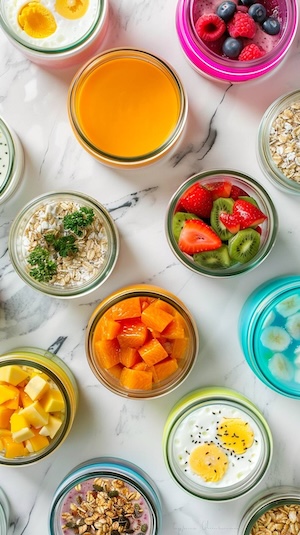Best Cereal for PCOS: Brands Ranked & Reviewed
Discover the best cereal for PCOS with our expert rankings. Compare brands, check ingredients, and find PCOS friendly cereal that supports hormonal balance.
Recipe by /contributors/nigella-lawson If you've never encountered struffoli before, they are best described—visually at any rate—as the croquembouche of southern Italy: small dough balls, and I mean really small, the size of marbles, that are deep-fried
This recipe includes superfoods such as:
Transform your health with tailored 7-day meal plans designed specifically for PCOS management. Just $7/month or $59/year.
Get it now →2 tablespoons semolina
6 eggs
1 tablespoon sugar
zest 1 unwaxed lemon, finely grated
2 tablespoons olive oil
3 –3 1/3 cups flour, plus more for rolling
1/2 teaspoon baking powder
2 1/2 –3 quarts flavorless vegetable oil, for frying
1 1/2 cups honey
approx. 2 teaspoons Christmas sprinkles, to decorate
Get out a large, rimmed baking sheet and shake the semolina over the base. And get out another tray (it doesn't have to be a baking sheet) and line it with a double layer of paper towels. Set both aside while you get on with the dough.
Beat the eggs, sugar, finely grated lemon zest, and 2 tablespoons of olive oil until frothy. Gradually add about 2 2/3 cups of the flour and the baking powder, and mix to a dough. If it is too sticky, then add more flour and keep kneading, using either your hands or a freestanding mixer fitted with a dough hook, until you have a smooth, pliable dough. This doesn't take very long: probably around 3 minutes or 5 by hand.
Flour your work surface and turn out your dough. Then divide the dough into 10 roughly equal pieces, each about the size of a golf ball. Take 1 ball and roll it into a rope approx. 1/2 inch thick, then with floury hands divide this into about 20 small pieces, and roll each piece between your hands (flouring them again if this helps) to make marble-sized balls.
Place the formed balls of dough on the semolina-sprinkled baking sheet, as you shape them. Repeat the process with the remaining golf-ball-sized portions of dough: you should make a staggering 200 of the tiny balls!
Heat the vegetable oil in a wide, heavy pan—about 11 inches diameter and at least 6 inches deep—and then when the oil is at 375 °F but no higher (you can leave a preserving or candy thermometer in, if you want), or a piece of bread sizzles and browns immediately when dropped in the pan, you can begin to cook the dough balls. Regulate the temperature and keep a careful eye on the pan and the oil all the time.
Gently lower, using a mesh scoop or perforated spoon, about 15 little dough balls at a time. At first they will sink and then, as they cook, they'll float to the surface and begin to turn golden brown. This will take up to about 1 minute depending on how many you have in at a time, but be ready to fish them out with your mesh scoop or perforated spoon onto the paper towel–lined tray as soon as they become the right golden color. And keep watching your pan.
Continue to cook them in batches—making sure the oil returns to the correct temperature but doesn't get too hot or bubble too vigorously—until they are all fried; you can pile them up on the tray without harm. Now turn off the heat under the oil pan, and move on to the adhesive and assembly stage.
Pour the honey into a roasting pan that can go on the stove, and heat very gently until it becomes runny—a matter of moments, so do not leave the pan—then take it off the heat.
Tip all of the fried dough balls into the warmed honey and, using a soft spatula, turn them gently to coat them. Get out a large plate or cake stand with a slight lip or rim and, with wet hands, check the balls are not too hot then pick up the sticky balls and arrange them around the outer edge of the plate in the shape of a bobbly wreath, leaving just a small empty circle in the middle. Do not worry about symmetry or perfection or counting dough balls here, please.
Wash the honey from your hands and shake your chosen sprinkles over the sticky wreath, then stand back and admire, before placing your creation where others can do likewise. These struffoli are best, to my mind, eaten on the day they're made. Use a scoop or spoon and fork to serve. It will be a sticky affair, but that's part of their charm.

You know the drill: Alarm goes off. You hit snooze. Rush around frantically. Skip breakfast AGAIN because there's no time. By 10am, you're hangry, your blood sugar is all over the place, and your PCOS symptoms are already acting up.
Sound familiar?
Finally – a meal prep system designed specifically for women with PCOS who refuse to let chaotic mornings derail their health goals.
In just ONE hour on Sunday, you can transform your entire week:
"I went from skipping breakfast 4 days a week to having delicious, hormone-supporting meals ready every morning. My energy is more stable and my cravings have disappeared!"
– Sarah M.
Stop letting chaotic mornings control your health.
Get your hormone-happy mornings starting this Sunday.
→ Get Your 60-Minute Solution Now
Transform your health with tailored 7-day meal plans designed specifically for PCOS management. Just $7/month or $59/year.
Get it now →Serving Size: 10
| Amount Per ONE Serving | ||
|---|---|---|
| Calories 0 kcal | ||
| Fat 0 g | ||
| Carbohydrate 0 g | ||
| Protein 0 g | ||
💡 Introducing the 10/10 PCOS Solution:
Ten Delicious Crockpot Recipes that take just 10 minutes to prep!
Say goodbye to hours in the kitchen and hello to clean, PCOS-friendly meals made effortlessly.
👉 Click here to grab your 10/10 PCOS Solution today! Try The 10/10 PCOS Solution: Ten Crockpot Recipes That Take Just Ten Minutes to Prep
Managing PCOS can be challenging, but you don't have to do it alone. Join our supportive community to connect with others who understand what you're going through, share tips, and get encouragement. Here's how you can get involved:
Subscribe to our Newsletter: Receive PCOS-friendly recipes, tips, research updates, and more delivered straight to your inbox. Stay informed and empowered with the latest information and support.
Join our Telegram Channel: Stay updated with the latest tips and advice on managing PCOS.
Follow PCOS Meal Planner on Facebook: Engage with our community, participate in discussions, and get support from others.
Break the cycle with the PCOS Meal Planner - your personalized guide to eating better, feeling better, and managing PCOS symptoms. Take control today!

Forget the frustrating cycle of weight loss attempts, endless medications, and living in discomfort. Introducing the PCOS Meal Planner. A meal planning guide that goes beyond temporary fixes to offer a comprehensive strategy, empowering you to ignite a transformation towards lasting health and happiness. Step into a world where you control your PCOS, not the other way around.
Unlock Your PCOS Freedom Now.
Discover the best cereal for PCOS with our expert rankings. Compare brands, check ingredients, and find PCOS friendly cereal that supports hormonal balance.
Learn how to transition away from fruit when starting a ketogenic diet for PCOS. Discover gradual strategies, fruit alternatives, and practical tips for success.
Discover 5 delicious PCOS banana bread recipes with low-glycemic ingredients. Learn how to make hormone-friendly banana bread that supports blood sugar balance.
Creatine for women with PCOS explained simply. Learn safety, benefits, hormone effects, tips, and how creatine may support PCOS symptoms naturally.
Complete PCOS diet plan with foods to eat, foods to avoid, meal timing, and real results. Learn the science-backed approach to managing PCOS through diet, with 7-day meal plan, grocery list, and step-by-step implementation guide. Based on clinical research and real patient outcomes.
Complete guide to ordering at Wendy's with PCOS. Discover the best protein-focused meals, what to skip, and how to customize orders to keep blood sugar stable. Learn which burgers, salads, and sides work for PCOS, plus complete macros for every menu item and smart swaps to avoid insulin spikes.
Complete guide to ordering at Burger King with PCOS. Discover the best protein-focused meals, what to skip, and how to customize orders to keep blood sugar stable. Learn which burgers, salads, and sides work for PCOS, plus complete macros for every menu item and smart swaps to avoid insulin spikes.
Discover 30+ delicious PCOS-friendly smoothie recipes that stabilize blood sugar and support hormones. Each recipe includes protein macros, glycemic load, and hormone-balancing ingredients. Find breakfast smoothies, post-workout options, green smoothies, and dessert alternatives - all designed to prevent insulin spikes while satisfying cravings.
Discover the best supplements for PCOS backed by clinical research. Learn which supplements improve insulin resistance, reduce androgens, support ovulation, and balance hormones. Complete guide with dosages, timing, brands, and what to avoid. Evidence-based recommendations for inositol, vitamin D, omega-3, berberine, and more.